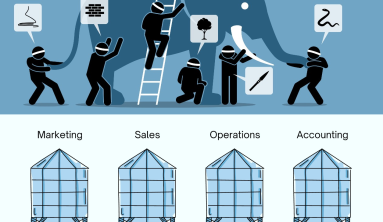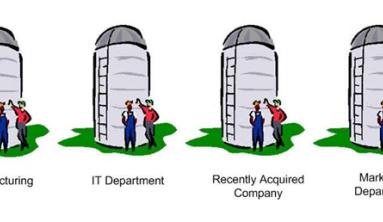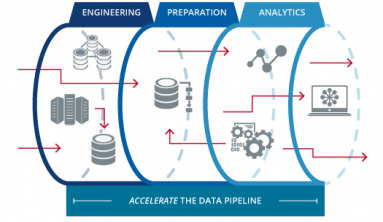DATA SILOS: THE ACHILLES HEEL OF LARGE ORGANIZATIONS
Quick question: how do you determine strategic choices for your business?
While qualitative decision making is a viable approach, you also want to have an understanding of the underlying numbers to help you make the most informed and optimal choice.
In the modern age, companies are unable to come up with decisions without relying on accurately collected data. The biggest obstacle to using precise data analysis is not even the technology or skills required. It is accessibility or rather inaccessibility to the data. In fact, 47% say data siloing and accessibility are the biggest challenges to gaining insight from marketing data.
May companies still suffer from data silos, which are a big blocker for good decision making. Read on to learn how to break down data silos in your company.
What Exactly Are Data Silos?
A data silo, also known as an information silo, is a repository of information in an organization’s department that remains under the control of the said department but is isolated from the rest of the organization.
Much like grain in a farm is sheltered from the elements, a business silo is a mentality or culture that prevents team members from one department from sharing data and information, developments or even technologies with members from other departments.
Are data silos a natural way of doing business?
While data silos seem like a normal business practice, they harm your company’s growth. They prevent you from reaching your full potential since data is locked away from general use or generalized access, thus impeding productivity.
Going back to the physical silo analogy, locking up grain in a silo means it is unusable for its intended purpose unless it is moved from the silo into the world. The solution to the big silo problem is finding a way to move the data from isolation. This ensures data integration among all departments in your organization.
Why Do Data Silos Occur?
Isolated islands of information result from a wide variety of factors. Here are the most common scenarios from organizations suffering from data silos:
1. Technological
Without access to proper technology, data cannot pass smoothly between several departments in a company. Specialized applications for fast and convenient data sharing are required. Even so, members from all departments need to be well trained in using the technology.
2. Company Growth
At times, a company may grow to a point that sharing information becomes difficult. It may be due to many departments, offices around the globe, or just too many employees. A company growing too fast may also result in structural issues.
3. Workplace Culture
Unhealthy competition or animosity between teams may lead to those departments withholding information from one another instead of working in unison.
4. Vendor Lock-In
Vendor lock-in is where a vendor wants to keep you within their cloud platform. Companies should therefore utilize multi-cloud data management instead of relying on only one vendor.
5. Political Reasons
Why do we keep secrets from even some of our friends? It is because the leak of information could result in others misusing that information, even accidentally. The same happens in organizations, but instead of secrets, teams keep information from one another.
The Consequences of Data Silos
While they seem harmless on the surface, data silos are like a hidden iceberg waiting to sink your company.
Data silos exist in virtually all companies. They tend to occur, especially in large organizations with several departments that have different priorities, goals, and responsibilities. A common factor lies within the very core of our organizations, the company’s structure.
Several departments within an organization are necessary for heightened focus and effectiveness. However, if the boundary between departments gets too thick, the free flow of information is soon impeded. It may result in:
1. Slowing down your business
We live in a fast-paced environment where we have to make informed decisions quickly. Waiting for information to be gathered from all departments then processed will have you lagging behind your competition.
2. Negatively impacting crucial areas of your business
Inaccurate spreadsheets hamper your financial planning and budgeting. Poorly organized data will overburden your IT staff. Incomplete performance management data from your HR guys will make it hard to recognize and reward the top employees or even notice if there’s poor team culture. You can remedy this by actively tracking contributions in real time using the right performance management software.
3. Limited communication and collaboration
The existence of data silos within a company means that your employees have limited access to information. Therefore, they cannot utilize the full value of the collected data. They also miss out on the chance to work together with a similar goal in mind.
4. A decrease in the quality and credibility of data
Of course, one of the biggest setbacks of data silos is this. Isolated data is useless, as it quickly becomes outdated or inaccurate. Such data can majorly affect the sampling or analysis of your company’s progress, rendering the findings inaccurate.
5. Storage space and accuracy
In the absence of a central system of data storage, employees who need quick access to data will save copies for themselves. Ten guys storing copies of the same information eats up your storage budget while still making it hard to figure out whose version is the latest.
Five Ways to Break Down Data Silos
To get the most out of your data, you need to access and analyze it in a fluid manner. That means getting rid of the data silos that, to be honest, most of the people working in your organization are not even aware of.
Now, how do you do this?
After that much pessimistic talk about data silos, you will be pleased to know that knocking down data silos is not as hard as many business owners think.
Here are several strategies that organizations use to eliminate data silos:
1. Encourage communication and collaboration
Most, if not all data silos, are created due to a lack of communication between various departments in an organization. For example, your marketing guys may be storing data on Google Drive while their colleagues in the sales department might be using Dropbox. This way, both teams may be unaware of where the other is storing their files. All this is while they are supposed to be working together in the first place.
You can get rid of such isolated data by encouraging your employees to collaborate in cross-functional teams. Using a good project management software is key to ensuring this.
2. Unify technology platforms
Nowadays, you would be surprised at just how many technologies are in use within a single department, let alone a whole organization. A department may have more than five databases in use, with many applications spread across them. It leads to an endless tangle of data silos due to incompatible technology stacks that can’t be integrated.
Simplifying and consolidating your data management systems to a unified central system will work wonders in eliminating data silos. Start by consulting your employees on their data collection methods. Afterward, decide on which systems should be merged or eliminated for a more efficient solution.
A unified view of your data also allows you to conduct more thorough customer analysis, this is especially true if you are running an online business such as an SaaS business where quality and quantity of customer data are paramount to success and strategic decision making.
3. Sift through outdated data
Yes, to create a data management solution that is usable, you have to go through months of outdated, isolated data. It is to ensure that the data you have is updated and accurate.
An easy way to do this would be having your entire company work together through it. While you will be able to weed out any unusable data, it doubles up as a team-building activity. You can then ensure your employees understand how to handle data and the data storage platforms which are approved.
For example, having all your sales data centralised and kept up to date makes it easier for sales managers to monitor each sales rep activity.. You can even use these sales KPIs as a starting point.
4. Move data into a central repository
How about moving all the data to a repository such as a data warehouse or a data lake? It is an ingenious way to exterminate data silos since all your employees will be able to access the data whenever they need it.
The extract, transform, and load process is the most common method of compiling multiple sources of data into a single target database. You can learn more about the ETL process here.
5. Avoid vendor lock-in
Vendor lock-in is a serious problem facing organizations that store data in the public cloud. Vendor lock-in makes migrating data from one platform to another both expensive and time-consuming. Vendors can also use golden handcuffs to incentivize you not to leave their program at all.
To avoid such data silos, you need to use a flexible solution that gives you data autonomy or the ability to transfer your data out of the cloud whenever you want. You can even use a hybrid cloud strategy to remedy this.
Conclusion
As organizations grow, data silos increasingly become a significant threat. Many companies cannot reach their full potential because of restricted access to their own data. The good news is that there are many techniques you can use to get rid of this real headache.
Preventing data silos will allow your organization to share data among teams to help drive sales. When you take steps to deconstruct your data silos, you will witness results almost immediately.
Via clicdata





